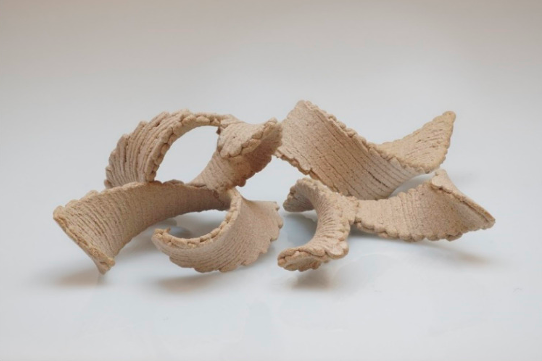We have seen shape memory properties in metals and plastics, but this may be a first for wood. Researchers from the Hebrew University of Jerusalem have created a 3D printing technique that can fabricate wooden structures in one orientation that then dry into another!
3D Printing Wood Ink
Doran Kam, a Ph.D. student at the university, led the group who developed this new methodology as they took sawdust, old wooden scrapings, and other wooden waste and turned that pulp into a printable ink. This ink was then deposited from a syringe extruder mounted to a Hyrel3D 30 M 3D printer. Inspired by previous research, the scientists determined that, by controlling the speed of the print and the direction in which they printed, they could control how the wood deformed as it dried.
“90° oriented bilayers. (a) printed object “as printed”, wet length = 60 mm, wet width = 15 mm. (b) Curvature as a function of printing speed measured at two different locations: center and side, blue and orange markers, respectively. (c) Dried 3D warped objects at different velocities, scale bar indicates 10 mm, demonstrating an increased effect at higher velocities.” Image courtesy of polymers.
3D Printing Furniture
So far, the scientists have been able to print a variety of shapes, including domes, cones, bowls, and saddles. Sizes of the prints vary, but the current limit is about one meter in size. In the future, the group hopes to build a printer that will have triple the build volume and can be used to print functional furniture.
In parallel to that effort, Kam’s group is also exploring methods to create more complex shapes and methods to 3D print reversible shape-changing objects, as well. Both are exciting avenues for research, and if it allows us to compost our own wood waste and turn it into something new, we are excited to see what comes of it.
While 3D printing wood isn’t novel, being able to have wooden prints exhibit shape changing capabilities is. This could offer a more environmentally stable solution for 3D printing and may offer a way to reduce our dependence on oil and gas as our world shifts to renewable energy inputs and materials.
More research will have to be done before this product is economically viable, but it could be here sooner than we think; especially if the group’s past progress is any indicator. They have been hard at work since they first published their method on their wood 3D printer back in 2019, and now offer a way to 3D print shape changing woods. If this momentum continues, they could potentially reach their goal of creating 3D printed wooden furniture in the near-term. Who knows, it may become the next “mattress-in-a-box” trend. We only hope their furniture is as comfy as the beds we sleep in, too.
